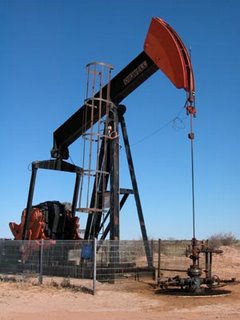The U.S. gets its oil from two sources: either it pumps its own oil, called "Field Production" by the Department of Energy, or it imports oil from other countries around the world. In 2000, American commercial field production made up 38.69% of the total supply of crude oil, while imports made up 60.28%. In 2005, when I wrote the last post, those same percentages were 33.67% and 65.84%, respectively. (These numbers are different from what I wrote back in 2006 as adjustments have been made to the official statistics; these types of revisions are normal for economic statistics.) In 2007 (the most recent year), the percentages were 33.72% and 66.19%, respectively. While there has been an extremely slight increase in the amount of oil pumped domestically (0.05%), imports have also increased as well. (The reason why both numbers can increase is because a third number, "supply adjustments," fell.)
In 2007, the U.S. imported a total of 3,656,170 thousand barrels. Of those 3.66 billion barrles, the U.S. imported from a total of 46 different countries. The top 5 importing countries were: Canada (18.61%), Saudi Arabia (14.50%), Mexico (14.07%), Venezuela (11.48%), and Nigeria (10.80%), for a total of 69.47% of all American imports. In contrast, imports from countries six through ten (Angola, Iraq, Algeria, Ecuador, and Kuwait) made up only 17.95% of the total; countries 11 through 46 made up the remaining 12.58%.
Looking at petroleum imports in two other ways...
Conclusions/Predictions:
Two years ago, I made four points as to how I thought things would go with respect to American oil imports and consumption. We'll look at how good or bad those predictions were:
1. American field production will probably go below 25% of its total annual supply within the next five years.
I think we can write this prediction off; I don't foresee this happening within the next three years (or perhaps even the next ten).
2. In that same time frame, imports will probably be in the high 50s percentage (perhaps 58-59%).
On the other hand, I think this prediction is very much a lock at this time. In fact, I wouldn't be surprised if this number goes back up again, remaining in the 60-65% range.
3. America will continue to seek the majority of its oil from non-OPEC countries, such as Canada and Mexico, if only to avoid being as dependent on OPEC countries as they have been in the past. However, this will probably turn out to be a pipe dream in the long run unless Canadian oil reserve estimates turn out to be near the high end. (Estimates for Canada's proven oil reserves ranges from 4.7 billion barrels (World Oil) to 14.803 billion barrels (BP Statistical Review) to 178.792 billion barrels (Oil & Gas Journal). Obviously, this extremely wide range of guesses shows that no one truly knows how much oil Canada has.)
Since I wrote this, I've gotten a better understanding with respect to Canada's oil reserves. The problem with the Canadian oil sands is that it is made up of a very dense and viscous type of petroleum called bitumen. Bitumen is like molasses at room temperature, and needs heating just to flow. (The tar that we pave roads with is bitumen.) Oil refineries are set up to process certain types of crude oils, and bitumen is normally not one of them. So, while Canada has a lot of proved oil reserves, most of it is not in the form the refineries need to produce products like gasoline. In this respect, the lower reserve amount mentioned above is probably closer to the amount of crude oil Canada actually has. In time, more refineries may convert to take advantage of the Canadian oil sands, but that will probably be a gradual process.
4. Persian Gulf oil, which has ranged between 19.81% and 28.56% of all U.S. imports since 1996, will probably continue to hover in the high teens-low 20s, despite President Bush's goal to cut American consumption of Middle Eastern oil by 75% by 2025, per the latest State of the Union address.
I don't see this forecast changing at all. What President Bush said in 2006 about cutting the amount of Middle Eastern oil America consumes was complete and utter bullshit (and shame on you if you believed him). BTW, shame on you again if you believe either McCain or Cheney that drilling for oil offshore or up in Alaska will make a significant difference. Two reasons: "drop in the bucket" and "long-term projects," neither of which will lower your gas prices. I may post on this in the near future, insha'allah, but in the meantime I recommend that you read John McCain's Oil Scam over at Informed Comment (Juan Cole), and Drilling Our Way to... by Menzie Chinn over at Econbrowser.
References:
US Crude Oil Supply and Disposition (DoE)
US Crude Oil Imports by Country of Origin (DoE)
Notes:
* OPEC countries include Algeria, Angola, Ecuador, Indonesia, Iraq, Kuwait, Libya, Nigeria, Qatar, Saudi Arabia, the UAE, and Venezuela.
** Persian Gulf countries include Bahrain, Iran, Iraq, Kuwait, Qatar, Saudi Arabia, and the United Arab Emirates. However, Iran and Qatar export no oil to the U.S.

